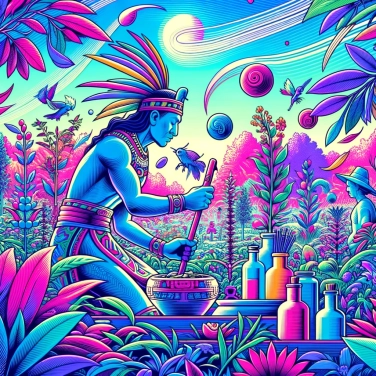The Aztecs cultivated medicinal plants in their sacred gardens to treat physical and spiritual illnesses, as they believed in the healing power of these plants and considered them as offerings to the gods.

Among the Aztecs, medicinal plants were much more than mere remedies: they had a profoundly spiritual significance. Each plant was linked to a specific deity, forming a bridge between the world of humans and that of the gods. For example, certain herbs were used during religious ceremonies to attract divine favor or drive away evil spirits. Thus, gathering, preparing, or even using these plants was never a trivial act, but always imbued with strong religious meaning. Sage and agave, in particular, played a key role in sacred rites to purify both the body and the mind. For the Aztecs, caring for one's body often meant caring for one's soul.
The Aztecs reserved special spaces for their sacred gardens. These places were considered privileged spots where priests cultivated precious medicinal plants. They were used as much to develop remedies for diseases as to organize religious rituals related to the deities. These gardens were regarded as spaces filled with spiritual energy, perfect for soothing both body and spirit. Cultivating medicinal plants here allowed for the enhancement of their healing power, combining physical care, religious beliefs, and spiritual practices. These sacred gardens were an integral part of daily life: they healed the body, protected the soul, and ensured a good connection with the Aztec gods.
The Aztecs had an advanced knowledge of plants that they used to heal all sorts of illnesses. They knew exactly which plants alleviated pain, reduced fever, or promoted healing: a true open-air pharmacy! Aztec healers passed down botanical knowledge from generation to generation, carefully observing the properties of plants: some, like wild mint (iztauhyatl), were used for digestive issues, while others, like the famous cacao, were used to combat fatigue and restore strength. Their medicine was based on a subtle mix of concrete observations and a bit of mysticism: each plant had recognized physical properties, but often also possessed a little something sacred or mysterious. Clearly, their knowledge was far from approximate: they had developed detailed and precise classifications of plants, along with their preparation methods and various therapeutic effects.
Among the Aztecs, medicinal gardens were genuine places of social life. People came there to exchange knowledge about plants, but also to meet and help each other. The cultivation of medicinal plants was not a solitary job: the whole community gathered to share the harvest and learn together how to prepare remedies. The garden became a space for collective learning, where both young and old passed on valuable knowledge, thus keeping their tradition alive. Healers or "ticitl" played a central role in these communal spaces, connecting health, religion, and the daily life of the community.
Among the Aztecs, physical health was closely intertwined with spiritual beliefs: illness was seen as a religious or supernatural imbalance. Therefore, using medicinal plants aimed as much at appeasing displeased gods as at healing physical symptoms. Each plant had its special connection with a deity or a myth, and Aztec healers — types of priest-physicians called ticitl — made dual use of plants: to directly treat the sick body and to restore a sort of spiritual balance with the universe. This blend of medicine and religion also helped reassure people: if the gods were involved, the remedies seemed inherently a bit more powerful and effective.
The sacred Aztec gardens, known as Chinampas, were often built on floating artificial islands, representing an innovative ecological feat that is still studied today by scientists.
Some medicinal herbs used by the Aztecs, such as chia and amaranth, are now recognized as true superfoods due to their exceptional nutritional compositions.
Aztec medicine was closely overseen by a specialized physician-priest known as a 'Ticitl', who possessed both practical skills in botany and spiritual and religious abilities.
The Aztec codex known as the 'Codex Badianus' (1552), regarded as one of the earliest medical works in the Americas, meticulously compiles the medicinal use of around 200 different plants utilized by this civilization.
Yes, the Aztecs had specialized healers called 'ticitl', who possessed both medicinal skills and a deep spiritual knowledge. These healers cultivated and used plants from sacred gardens to treat patients and perform therapeutic rituals.
Each Aztec medicinal plant held a symbolic and spiritual significance and was often dedicated to a specific deity. This association reflected the Aztec beliefs that the healing powers of plants partly derived from the worshipped deities, thereby strengthening the connections between spirituality, nature, and healing.
The sacred Aztec gardens were important community spaces that provided both physical and spiritual care. They fostered the exchange of medicinal and botanical knowledge, ensured the availability of therapeutic resources, and strengthened the social bonds among community members.
Yes, Aztec medicinal knowledge still influences some therapeutic practices today, particularly in Mexico. Plants like agave, nopal, and sage continue to be used in modern herbal medicine, a direct legacy of the ancestral medicinal knowledge of the Aztecs.
The Aztecs used a variety of medicinal plants, including sage, aloe vera, chili pepper, cacao, maguey (agave), and several species of cactus like nopal. These plants were used to treat various ailments ranging from burns to digestive disorders, as well as inflammatory pains and infections.

0% of respondents passed this quiz completely!
Question 1/5